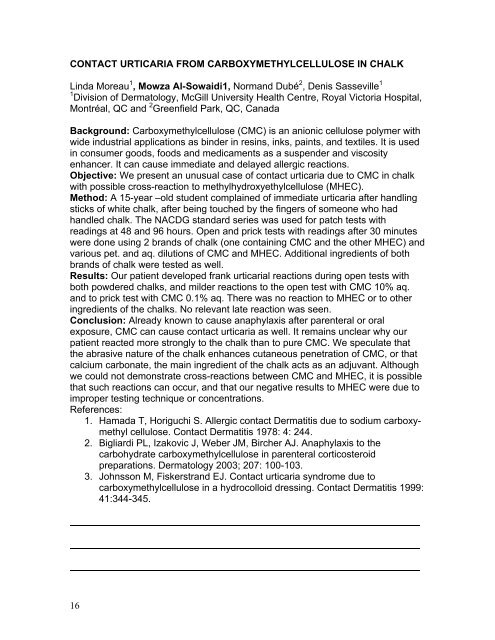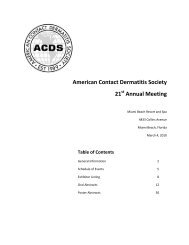2006 Abstracts - American Contact Dermatitis Society
2006 Abstracts - American Contact Dermatitis Society
2006 Abstracts - American Contact Dermatitis Society
- No tags were found...
You also want an ePaper? Increase the reach of your titles
YUMPU automatically turns print PDFs into web optimized ePapers that Google loves.
CONTACT URTICARIA FROM CARBOXYMETHYLCELLULOSE IN CHALKLinda Moreau 1 , Mowza Al-Sowaidi1, Normand Dubé 2 , Denis Sasseville 11 Division of Dermatology, McGill University Health Centre, Royal Victoria Hospital,Montréal, QC and 2 Greenfield Park, QC, CanadaBackground: Carboxymethylcellulose (CMC) is an anionic cellulose polymer withwide industrial applications as binder in resins, inks, paints, and textiles. It is usedin consumer goods, foods and medicaments as a suspender and viscosityenhancer. It can cause immediate and delayed allergic reactions.Objective: We present an unusual case of contact urticaria due to CMC in chalkwith possible cross-reaction to methylhydroxyethylcellulose (MHEC).Method: A 15-year –old student complained of immediate urticaria after handlingsticks of white chalk, after being touched by the fingers of someone who hadhandled chalk. The NACDG standard series was used for patch tests withreadings at 48 and 96 hours. Open and prick tests with readings after 30 minuteswere done using 2 brands of chalk (one containing CMC and the other MHEC) andvarious pet. and aq. dilutions of CMC and MHEC. Additional ingredients of bothbrands of chalk were tested as well.Results: Our patient developed frank urticarial reactions during open tests withboth powdered chalks, and milder reactions to the open test with CMC 10% aq.and to prick test with CMC 0.1% aq. There was no reaction to MHEC or to otheringredients of the chalks. No relevant late reaction was seen.Conclusion: Already known to cause anaphylaxis after parenteral or oralexposure, CMC can cause contact urticaria as well. It remains unclear why ourpatient reacted more strongly to the chalk than to pure CMC. We speculate thatthe abrasive nature of the chalk enhances cutaneous penetration of CMC, or thatcalcium carbonate, the main ingredient of the chalk acts as an adjuvant. Althoughwe could not demonstrate cross-reactions between CMC and MHEC, it is possiblethat such reactions can occur, and that our negative results to MHEC were due toimproper testing technique or concentrations.References:1. Hamada T, Horiguchi S. Allergic contact <strong>Dermatitis</strong> due to sodium carboxymethylcellulose. <strong>Contact</strong> <strong>Dermatitis</strong> 1978: 4: 244.2. Bigliardi PL, Izakovic J, Weber JM, Bircher AJ. Anaphylaxis to thecarbohydrate carboxymethylcellulose in parenteral corticosteroidpreparations. Dermatology 2003; 207: 100-103.3. Johnsson M, Fiskerstrand EJ. <strong>Contact</strong> urticaria syndrome due tocarboxymethylcellulose in a hydrocolloid dressing. <strong>Contact</strong> <strong>Dermatitis</strong> 1999:41:344-345.16






